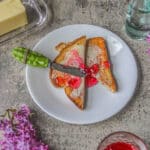Lilac Jelly Recipe
You will love this honey-like Lilac Jelly with delicate floral tones.
Servings: 6 ½ pint jars
Calories: 30kcal
Equipment
Ingredients
- 4 cups fresh lilac blossoms
- ¼ cup huckleberries (or blueberries)
- 4 cups water
- 1 medium lemon (juiced)
- 4 tablespoon RealFruit Classic Pectin (or 1 packet liquid pectin)
- 4 cups granulated sugar
Instructions
- Add lilac blossoms and huckleberries (or blueberries) to a saucepan and cover with 4 cups of water. Bring to a boil then simmer for 15 minutes over low heat. Turn the stove off and allow the flower infusion to steep for 4 to 8 hours.
- Strain lilac tea using a soup bag or fine sieve. Add lilac tea, lemon juice, and pectin to a small saucepan. Simmer over low heat as you stir the pectin into the tea to dissolve. Bring to a rolling boil for one minute.
- Add sugar and whisk to dissolve. Bring to a rolling boil for an additional two minutes. Skim foam off the surface and ladle hot jelly into sterilized hot jars. Leave ¼" headspace.
- Wipe rims with a clean dishcloth or a damp paper towel and screw the bands on hand-tight.
Water Bath Canning Instructions
- Add filled canning jars to the water bath canner. Make sure the water level is at least a few inches over the jars. Process the jelly jars in boiling water, based on the chart in this post.
Video
Notes
- Many lilac jelly recipes only call for 15 minutes of steeping. I prefer to steep the lilac blossoms for a longer period to extract as much of the delicious lilac flavor as possible.
- If you have a masher, use it to mash the berries to release their color.
- I tried freezing my lilac blossoms to use them later in the year and found that they degraded too much. For this reason, I only recommend using fresh lilac blossoms.
- Jelly needs to fully cool to set and may take up to 24 hours!
- If your jelly does not set, be sure to check out the link in the body of the post for troubleshooting tips.
- Sealed lilac jelly should last up to a year or more when stored in the pantry.
- Do not reduce the amount of sugar suggested in the recipe, if you do, the jelly will not set.
Nutrition
Serving: 96Tablespoons | Calories: 30kcal | Carbohydrates: 9g | Protein: 0g | Fat: 0g | Saturated Fat: 0g | Cholesterol: 0mg | Sodium: 3mg | Fiber: 0g | Sugar: 8g
